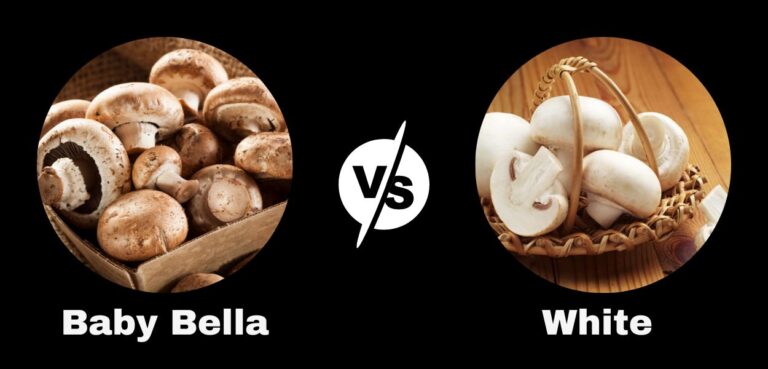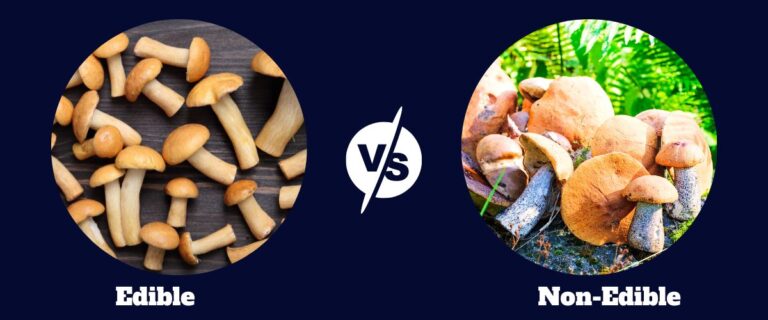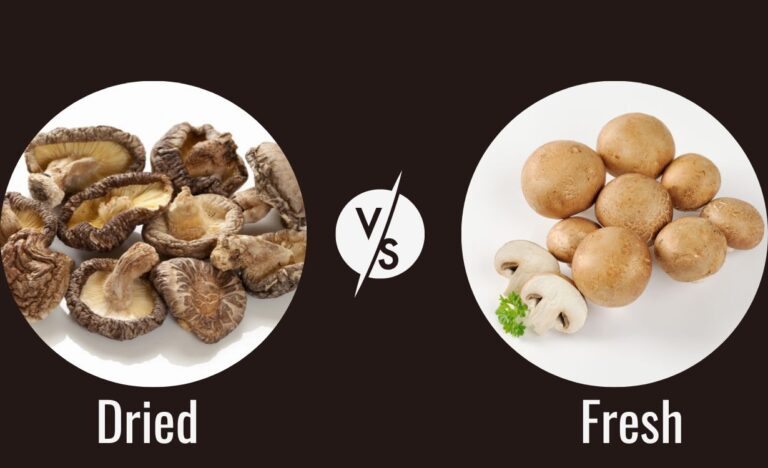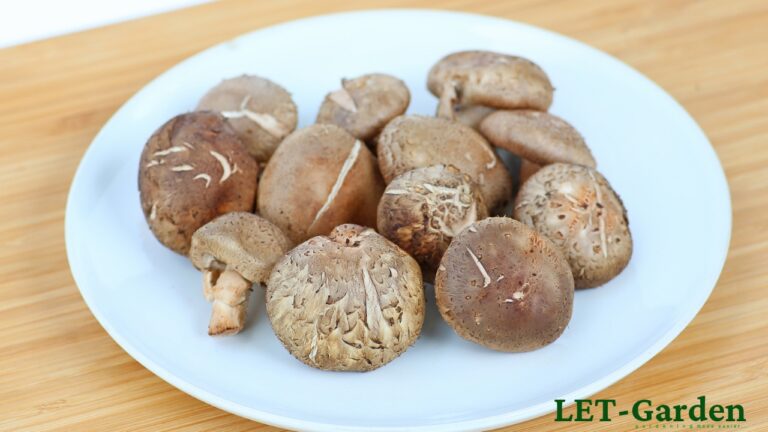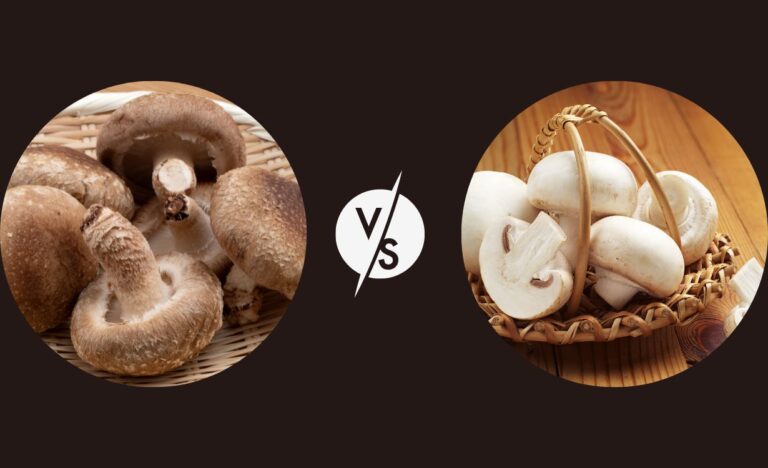
Shiitake Mushrooms vs Portabella
Mushrooms are a type of fungi that have been consumed for centuries for their unique flavor and nutritional value. Shiitake and Portabella mushrooms are two popular mushroom types that are often used in cooking. However, many people are not aware of the differences between these two types of mushrooms and may not know which one to choose for their recipe.
The significance of mushroom types lies in their diverse characteristics, including flavor, texture, and nutritional value. Different types of mushrooms also have different culinary uses and health benefits, making it important to understand the differences between them.
The purpose of this blog post is to provide a comprehensive comparison between Shiitake and Portabella mushrooms. By examining their nutritional value, flavor profile, culinary uses, availability, cost, and health benefits, readers will be able to make an informed decision on which type of mushroom to use in their cooking. Whether you’re a seasoned cook or a beginner, understanding the differences between these two popular mushroom types will help you elevate your dishes to the next level.
What are Shiitake vs Portabella Mushrooms?
Shiitake and Portabella mushrooms are two of the most popular mushroom types used in cooking. Understanding the characteristics of each mushroom can help you choose which one to use in your recipes.

Shiitake mushrooms
Shiitake mushrooms, also known as black forest mushrooms, are a type of edible mushroom native to East Asia. They are widely cultivated and highly prized for their unique flavor and nutritional value. Shiitake mushrooms have a meaty texture and a savory, earthy taste that makes them a popular ingredient in Asian cuisine.
The use of Shiitake mushrooms can be traced back to ancient Chinese medicine, where they were believed to have medicinal properties. Today, Shiitake mushrooms are commercially grown in various parts of the world, including the United States, Japan, and China.
Portabella mushrooms
Portabella mushrooms, also known as Portobello mushrooms, are a larger, mature version of the common button mushroom. They are native to Italy, where they were first cultivated in the 17th century. Portabella mushrooms have a rich, meaty flavor and a firm texture that makes them a popular meat substitute in vegetarian and vegan recipes.
Portabella mushrooms are also a good source of nutrients, including potassium, vitamin D, and fiber. They are commonly used in Italian and Mediterranean cuisine and are versatile enough to be grilled, roasted, sautéed, or even used raw in salads.
The physical appearance of each mushroom type:
Shiitake mushrooms have a tan to dark brown cap that is generally between 5-10 centimeters in diameter. They have a distinctive, slightly curved shape and a light-colored stem that is often discarded before cooking.
Portabella mushrooms, on the other hand, have a larger, flat cap that can grow up to 15 centimeters in diameter. They have a thick, woody stem that is often removed before cooking. The cap of a Portabella mushroom is dark brown to black and has distinctive gills underneath.
Availability of each mushroom type:
Shiitake mushrooms are widely available in most grocery stores and specialty food markets, both fresh and dried. Fresh Shiitake mushrooms are usually sold in prepackaged containers or loose and can be found year-round. Dried Shiitake mushrooms are also widely available and can be stored for longer periods.
Portabella mushrooms are also readily available in most grocery stores and can be found year-round. They are typically sold as fresh mushrooms in prepackaged containers or sold individually. Some specialty food markets may also carry Portabella mushroom caps, which are sold without stems and are suitable for grilling or stuffing.
Shiitake Mushrooms vs Portabella | Nutritional Values
Mushrooms are not only flavorful but they are also packed with important nutrients. Shiitake and Portabella mushrooms are no exception. In this section, we will explore the nutritional values of these two popular mushroom types.
Nutritional Value of Shiitake Mushrooms
Shiitake mushrooms are a great source of vitamins and minerals. They are high in B vitamins, especially vitamin B6, which help support the immune system and regulate mood. They are also a good source of vitamin D, which is essential for bone health and overall immune system function. Additionally, shiitake mushrooms are rich in minerals such as copper, selenium, and zinc, which are important for cell growth, immune function, and wound healing.
Health benefits: Shiitake mushrooms have been used for centuries in traditional Chinese medicine for their healing properties. They contain compounds called beta-glucans, which are known to boost the immune system and may help fight cancer. Shiitake mushrooms also have anti-inflammatory properties and may help lower cholesterol levels.
Nutritional Value of Portabella Mushrooms
Portabella mushrooms are also rich in nutrients. They are a good source of B vitamins, particularly riboflavin, which is important for maintaining healthy skin and eyes. Portabella mushrooms are also high in potassium, which helps regulate blood pressure and support muscle function.
Health benefits: Portabella mushrooms contain antioxidants, which protect the body against free radicals and may help prevent chronic diseases such as cancer and heart disease. They are also a good source of dietary fiber, which helps regulate digestion and promote feelings of fullness.
Comparison of Nutritional Value
Both Shiitake and Portabella mushrooms are rich in nutrients, particularly B vitamins. However, Shiitake mushrooms contain more vitamin D, copper, and selenium, while Portabella mushrooms are higher in potassium and dietary fiber. Additionally, both mushroom types contain antioxidants, but Shiitake mushrooms are known to have higher levels of beta-glucans, which may have immune-boosting properties.
Overall, both Shiitake and Portabella mushrooms are nutritious and delicious. When deciding which mushroom type to use, it is important to consider its nutritional value and health benefits, as well as its flavor profile and culinary use. Incorporating these mushroom types into your diet can provide a variety of important nutrients and potential health benefits.

Shiitake vs Portabella Mushrooms | Flavor Profile and Culinary Use
Mushrooms are a versatile ingredient in cooking, adding depth of flavor and unique texture to a variety of dishes. Shiitake and Portabella mushrooms are two popular types of mushrooms with distinct flavor profiles and culinary uses.
The flavor profile of Shiitake mushrooms: Shiitake mushrooms have a savory, meaty flavor with a slightly smoky undertone. They are often described as having a robust umami flavor that is distinct from other types of mushrooms. Shiitake mushrooms have a chewy texture that softens when cooked.
Cooking methods: Shiitake mushrooms are commonly used in stir-fries, soups, stews, and sauces. They can be sautéed, stir-fried, grilled, or roasted to enhance their flavor. The stems of Shiitake mushrooms are tougher than the caps, so they are often removed before cooking.
Traditional and modern culinary uses: Shiitake mushrooms are a staple ingredient in Asian cuisine, particularly in Japanese, Korean, and Chinese dishes. They are often used in miso soup, stir-fries, and hot pot dishes. In modern cuisine, Shiitake mushrooms are used in vegan and vegetarian dishes as a meat substitute due to their meaty texture and umami flavor.
The flavor profile of Portabella mushrooms: Portabella mushrooms have a meaty, earthy flavor with a slightly sweet undertone. They have a chewy texture that softens when cooked, making them a popular meat substitute in vegetarian and vegan dishes.
Cooking methods: Portabella mushrooms can be grilled, roasted, sautéed, or baked to bring out their flavor. They are often used as a meat substitute in burgers, sandwiches, and pizzas. The gills of Portabella mushrooms are often removed before cooking to prevent them from turning dark and releasing excess water.
Traditional and modern culinary uses: Portabella mushrooms are commonly used in Italian and Mediterranean cuisine. They are often grilled or roasted and served as a side dish or as a meat substitute in vegetarian and vegan dishes. In modern cuisine, Portabella mushrooms are used in burger patties, stuffed with fillings, and as a topping for pizzas and salads.
Comparison of flavor profile and culinary use: Shiitake mushrooms and Portabella mushrooms both have a meaty, chewy texture that softens when cooked. However, Shiitake mushrooms have a more distinct umami flavor and are commonly used in Asian cuisine. Portabella mushrooms have a meaty, earthy flavor and are often used as a meat substitute in Italian and Mediterranean cuisine. Both types of mushrooms are versatile and can be used in a variety of dishes to add depth of flavor and texture.
However, Shiitake and Portabella mushrooms have distinct flavor profiles and culinary uses that make them popular ingredients in cooking. Understanding the differences between these two mushroom types can help you choose the best one for your recipe and take your dishes to the next level.
Availability and Cost | Shiitake Mushroom vs Portabella
When it comes to buying mushrooms, availability and cost are important factors to consider. Here, we’ll take a closer look at the availability and cost of Shiitake and Portabella mushrooms.
Geographic Availability of Shiitake Mushrooms
Shiitake mushrooms are native to East Asia and are commonly grown in Japan, Korea, and China. They are now also grown in other parts of the world, including North America and Europe. While they may not be as widely available as other mushroom types, they can usually be found at specialty markets or Asian grocery stores.
Seasonal Availability of Shiitake Mushrooms
Shiitake mushrooms are typically available year-round, but their availability may vary depending on the growing region and climate. In some regions, they may be more abundant during certain seasons, such as fall or winter.
Geographic Availability of Portabella Mushrooms
Portabella mushrooms are native to North America but are now widely cultivated in other parts of the world, including Europe and Asia. They are often available at most grocery stores and can be found fresh or pre-packaged.
Seasonal Availability of Portabella Mushrooms
Portabella mushrooms are available year-round, making them a convenient option for cooking any time of the year. However, their availability may still vary depending on the growing region and climate.
Cost Comparison Between Shiitake and Portabella Mushrooms
In terms of cost, Shiitake mushrooms are generally more expensive than Portabella mushrooms. This is partly due to their scarcity and the fact that they are often grown on logs, which makes them more difficult to cultivate. Portabella mushrooms, on the other hand, are more widely available and easier to grow, making them a more affordable option.
Moreover, while both Shiitake and Portabella mushrooms are widely used in cooking, their availability and cost can vary depending on factors such as region and season. When choosing between these two mushroom types, it’s important to consider your budget and the availability of the mushroom in your area. Regardless of which mushroom you choose, both Shiitake and Portabella mushrooms offer unique flavors and nutritional benefits that make them a delicious and healthy addition to any meal.
Shiitake vs Portobello Mushrooms: FAQs
If you’re a fan of mushrooms, chances are you’ve come across Shiitake and Portobello mushrooms in recipes. Here are some frequently asked questions about these two popular mushroom types:
Can you substitute shiitake for portobello mushrooms?
While you can substitute one mushroom type for another, it’s important to consider their different flavors and textures. If you’re looking for a meat substitute, Eat for Longer suggests using portobello mushrooms, while shiitake mushrooms are recommended as flavor enhancers.
Are shiitake mushrooms better for you than other mushrooms?
Shiitake mushrooms have several nutritional benefits, including being a good source of vitamin D2, vitamin D3, and vitamin D4. Vitamin D is important for our immune system, bone health, and cellular growth.
Do shiitake mushrooms taste different?
Compared to the mild taste of button mushrooms, shiitake mushrooms have a distinct smoky and savory umami flavor. This flavor is further enhanced when the mushrooms are dried, making them a popular choice for soups and stews.
Are portobello mushrooms good for you?
Portobello mushrooms contain non-nutritive compounds such as polysaccharides, polyphenols, and carotenoids, which have anti-inflammatory, antioxidant, and anticancer properties. In animal studies, mushrooms have been shown to stimulate immune cells and inhibit the growth and spread of cancer cells.
Should you wash portobello mushrooms before eating?
Yes, it’s important to clean portobello mushrooms thoroughly before eating or cooking to remove any dirt or debris. Begin by removing the stems, then gently rub any dirt off the caps using a paper towel or clean kitchen towel.

Hi, I’m Miles, the lead team member behind Gardeem.com. Besides being a passionate grower and writer, I’m a husband, father and grandfather to three! I started Gardeem in 2017 to provide simple and reliable gardening advice to everyone, regardless of their ability levels.


